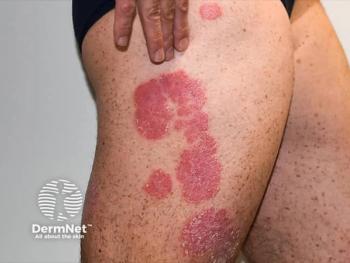
Real-World Data on the Adverse Effects of Apremilast and Deucravacitinib for Psoriasis
Key Takeaways
- Apremilast is linked to gastrointestinal issues, headaches, and psoriasis recurrence, with some new adverse events not on the label.
- Deucravacitinib shows cutaneous and oral adverse effects, with some conditions not initially included on the drug's label.
A recent analysis reveals safety profiles of apremilast and deucravacitinib for psoriasis, highlighting unique adverse events and long-term monitoring needs.
A new, post-marketing analysis has categorized the adverse events of apremilast and deucravacitinib for patients with psoriasis.1 The oral small-molecule inhibitors are both approved by the US Food and Drug Administration (FDA) for moderate to severe plaque psoriasis. Apremilast, a PDE4 inhibitor, is also approved for psoriatic arthritis while deucravacitinib, a TYK2 inhibitor, is being evaluated in clinical trials.2
“Given the widespread clinical use of apremilast and the potential of deucravacitinib as a newly approved drug for psoriasis treatment, evaluating their safety profiles has become a crucial area of research…there is a limited but crucial need for comprehensive safety analyses of these two drugs in post-marketing and real-world settings, as such studies may reveal safety characteristics distinct from those observed in clinical trials,” the authors said.
The pharmacovigilance, post-market study used information from the FDA Adverse Event Reporting System (FAERS) public database. Investigators analyzed adverse event reports from Q1 of 2014 to Q4 of 2023, aligning with when the treatments were brought to market. Demographic information regarding age, gender, reporting date, and region was extracted. The median age of apremilast patients was 56 years and 55 years for deucravacitinib. Most of the patients were from the United States. Females accounted for 63.65% of apremilast cases and 59.81% of deucravacitinib cases.
A total of 12,732,564 adverse event reports were extracted. In the final analysis, apremilast had 95,524 reports while deucravacitinib had 754. Apremilast had the greatest peak in reports in 2020. Deucravacitinib was not introduced until 2022 and has gradually risen in prevalence since then. The Reporting Odds Ratio (ROR), Proportional Reporting Ratio (PRR), and Bayesian Confidence Propagation Neural Network (BCPNN) analyses were conducted to determine the long-term safety of each therapy.
Patients taking apremilast were more likely to experience gastrointestinal adverse effects such as diarrhea, nausea, and abdominal discomfort. There was also a prevalence of headaches and psoriasis recurrence, which were all listed on the label. According to the disproportionality analysis, psoriasis rebound was the most frequently reported with 17,193 cases. Sinus headaches, allergies, and gallbladder disorders were not previously documented on the drug’s label but were reported in this analysis.
Patients taking deucravacitinib were more likely to observe cutaneous adverse effects, including acne, folliculitis, pruritus, rash, burning, urticaria, and erythema. Female patients had a higher risk of developing these skin reactions. Oral conditions like ulcers, pain, blistering, and herpes in the mouth were also prevalent. Specific skin conditions like acneiform dermatitis and rosacea were not originally included on the drug’s label.
“This may indicate that certain AEs manifest over prolonged treatment periods and are thus not captured in clinical trials, underscoring the necessity for clinicians to consider long-term drug impacts when managing chronic diseases like psoriasis,” the authors concluded.
All of these safety signals remained stable through temporal analysis, indicating that these risks are predictable, supporting effective long-term risk management. However, additional data on the risk associations of deucravacitinib use is needed to confirm, since this is a newer drug. Both categories did report some more serious outcomes, including hospitalization, death, and other life-threatening conditions but these were rare and not significantly significant.
The aforementioned patterns in adverse events may be closely linked to each drug’s mechanism of action, according to the authors. Clinicians are recommended to closely monitor these adverse events as more in-depth studies can establish the relationship between these drugs and adverse effects.
References
1. Xu Y, Liu X, Guo L, Jiang X. Adverse Events Associated with Apremilast and Deucravacitinib for Psoriasis: A Pharmacovigilance Study Based on the FAERS Database. Clin Cosmet Investig Dermatol. 2025;18:1121-1135. Published 2025 May 5. doi:10.2147/CCID.S439643
2. Hoy SM. Deucravacitinib: First Approval. Drugs. 2022;82(17):1671-1679. doi:10.1007/s40265-022-01796-y
Newsletter
Like what you’re reading? Subscribe to Dermatology Times for weekly updates on therapies, innovations, and real-world practice tips.


















